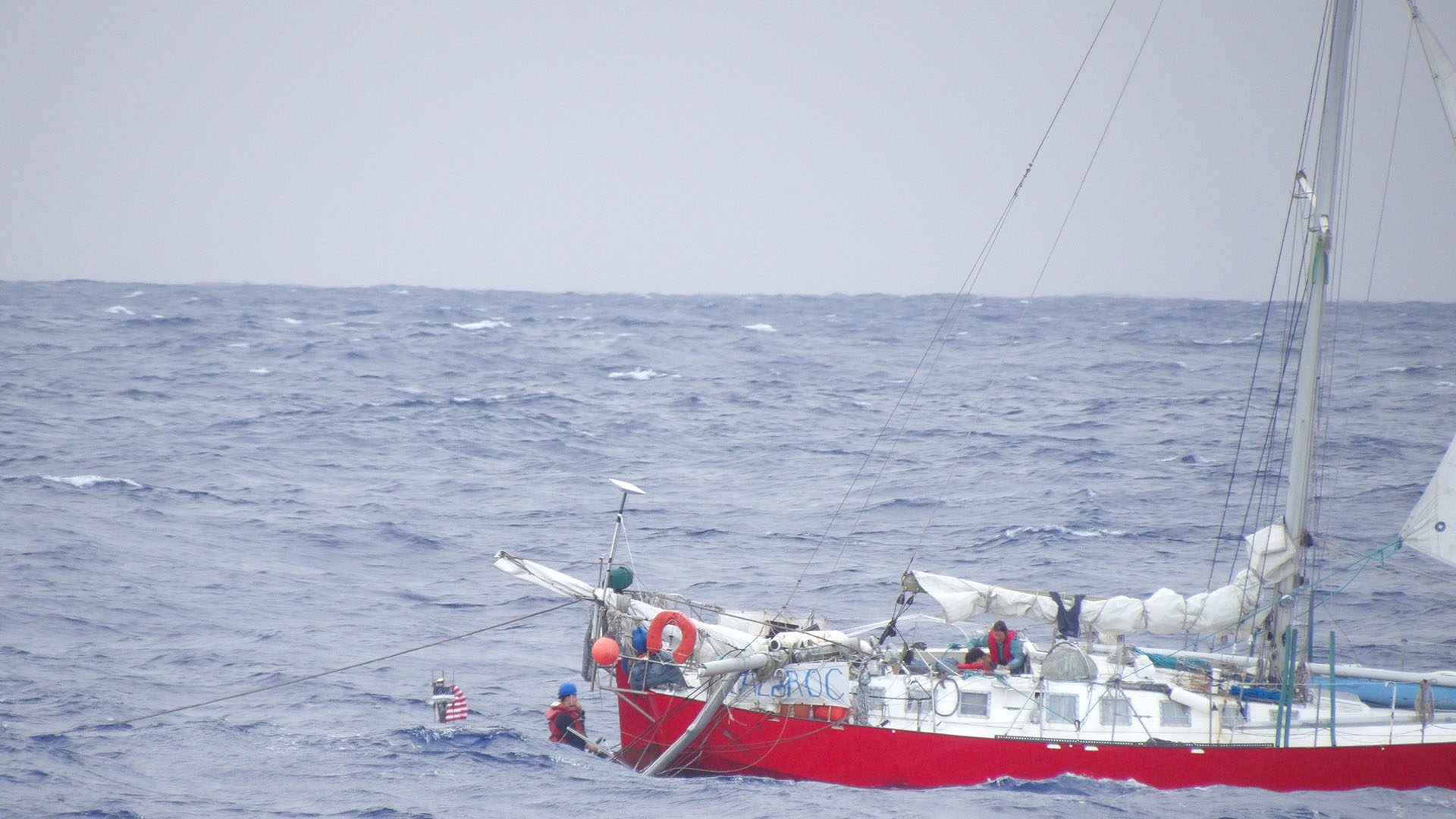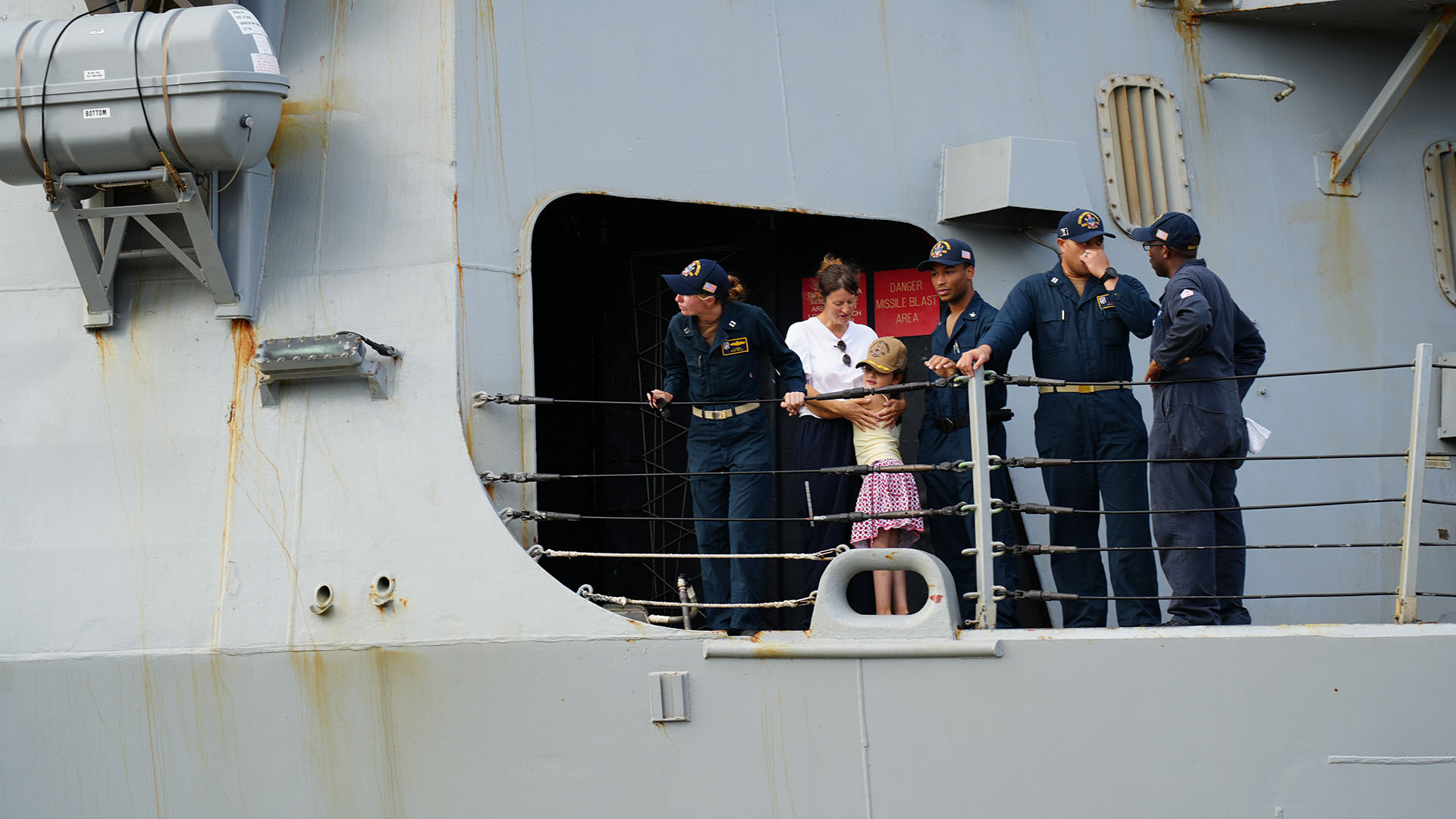Navy, Coast Guard, save mother, child stranded at sea as hurricane approaches
The Navy and Coast Guard spent three days coming to the assistance of a woman and her child aboard a stricken sailboat as a hurricane bore down on the vessel.Jeff Schogol
Posted on Sep 5, 2024 7:00 AM EDT

Nearly 1,000 miles east of Hawaii, a 47-year-old woman and her 7-year-old daughter were adrift on a French-flagged sailboat amid rough seas, along with their cat and tortoise.
The boat’s captain had died during their voyage, and a Category-2 hurricane was bearing down on them.
For the next three nerve-wracking days, the Coast Guard and Navy raced against time and the worsening weather to get the woman, her daughter, and their pets off the boat before the hurricane arrived.
Kevin Cooper of the Coast Guard served as the search and rescue mission coordinator during the operation.
The Coast Guard first learned that the vessel was in distress around 12:33 p.m. on Aug. 24 when they picked up a distress alert from the sailboat’s emergency position indicating radio beacon, or EPIRB.
The device relayed the boat’s position, but rescuers initially had no idea what type of emergency was unfolding, Cooper told Task & Purpose.
A Coast Guard HC-130 Hercules flew to the scene and heard the woman’s mayday call over the radio, but they could not communicate with her because her VHF radio ceased to be able to transmit.
“She had been on the radio every 30 minutes or so just calling out — kind of into the blind — for anybody around who might hear,” said Cooper, a retired Coast Guard lieutenant commander. “She speaks a very small amount of English, enough that she knew to be on the radio and to say that they had one deceased crew member and then it was her and her daughter on the vessel and that they needed assistance.”
The woman lit emergency flares as the C-130 flew overhead. The boat had a small sail rigged but it was drifting without any motor power. The Coast Guardsmen in the plane noted that waves were crashing over the side boat, and some of the water was flooding the vessel’s cabin. Even a little bit of water would change the boat’s stability and could lead to an even more dire situation.
The C-130 stayed until it had just enough fuel to return to base. Another Hercules arrived at the scene at 9 a.m. the following day and the aircrew saw the woman and her daughter “waving their arms before retreating inside the cabin,” a Coast Guard news release says.
“I think that she was growing concerned because the storm was expected to come right through their location, and she knew that time was not on our side for effecting a rescue,” Cooper said. “They needed to get on a surface vessel and then clear the area to avoid the storm.”
The Coast Guard was able to reach the Seri Emperor, a Singapore-flagged liquid petroleum gas tanker, which arrived on the scene at roughly 5:20 p.m. that day. But the ship’s captain determined that the seas were so rough that it was too dangerous for the crew to launch a small boat to rescue the people aboard the sailboat, Cooper said.
The Seri Emperor’s captain agreed to remain on the scene to monitor the situation.
Rescuers had also reached the U.S. Navy destroyer William P. Lawrence, which arrived at 5 a.m. on Aug. 26. By then, the destroyer’s crew only had a few hours to get the passengers on the sailboat to safety before the hurricane arrived, so things were coming down to the wire.

“It was particularly anxious for all of the folks who were involved in planning this rescue, both with the Coast Guard and with the Navy because the clock was ticking, and we knew that they had a very small window to be able to get their boat in the water to do this rescue,” Cooper said. “We all get very emotionally invested in the outcome of these cases, and especially this one: Knowing that a 7-year-old girl, that her life was threatened, I think we’re all very protective of the children.”
Despite the worsening sea conditions, crew members from the William P. Lawrence were able to launch their small boat. The sailors braved 10-foot waves to race toward the stricken sailboat.
“The ocean is just wild — it’s something of an uncontrolled environment,” Cooper said. “Also depending on the period of the waves — basically how close they are together to where when you come off the top of one wave, you’re basically crashing into the back of the next one — it’s like being inside of a washing machine, where you’re just constantly being thrown around.”
Such missions also require rescuers to be in constant communication with the people in trouble so they can move the people to safety as quickly as possible, he said.
Three of the William P. Lawrence sailors who took part in the rescue told Task & Purpose how the operation unfolded.
“We spent lot of time the day before planning, discussing what-ifs and contingencies, with decision points like ‘should it be a [Rigid Hull Inflatable Boat] recovery or shipboard recovery, or what we would do if they refused to get into the RHIB,’” said Navy Lt. Stuart Sloat, a weapons officer aboard the destroyer and the search and rescue swimmer of the boat crew that day.
Despite the 8 to 10-foot seas and 15-mile-per-hour winds, Navy Hospital Corpsman 2nd Class Jesus Espana described the approach to the sailboat as “moderately dangerous.”
“Small boat operations always have some element of risk, and the seas were deteriorating while we were out there, but we knew that saving the lives of the mother and daughter was worth it,” said Espana, the medic aboard the boat. “Fortunately, the mother appeared to be healthy and in reasonably good spirits, as did her daughter, which made recovery easier than if they had been dehydrated or sick.”
The sailboat’s aft mast was broken off and trailing behind the vessel, and the rough seas made it difficult for the sailors to determine how to safely approach the boat, said Seaman Micheal Hunter, who drove the small boat.
“The movements of the boat were unpredictable because it was just adrift — the crew wasn’t steering it,” Hunter said. “The swells were coming from behind us. I’d look to see when there was a period of flat seas astern and time a run at the sailboat, but we could only pull alongside them for a couple of seconds at a time before we broke away — we had to make an approach for every transfer.”
When the sailors reached the sailboat, Sloat told the woman that they were with the U.S. Navy.
“But she looked confused,” Sloat recalled, “So I said, ‘Français’ — at which point I handed the megaphone to our first lieutenant who speaks fluent French.”
Cooper said it “felt like forever” as he and the other rescuers waited to hear the sailors had been able to get the passengers and their pets aboard the Navy’s small boat.
“The real sigh of relief was when they said that they had everyone safely aboard the Navy vessel, the William P. Lawrence, because then we knew they were in the hands of the finest Navy on the planet,” Cooper said.
French officials will determine the cause of the sailboat captain’s death, Cooper said. The sea was so rough that the William P. Lawrence’s captain decided it was too dangerous to recover the man’s body.
As soon as the woman and her daughter were aboard the destroyer, Cooper knew that the ship would be able to reach safe waters before the hurricane arrived.
“A great relief for me because I didn’t sleep for two nights before that,” Cooper said. “The need to create an achievable rescue plan with all of these factors was really difficult. Then when the Navy said that they would go, we definitely did not feel like we were in the clear, but we did feel like we had an incredibly capable resource with some of the finest trained mariners you could ask for to help effect this rescue. It was still a nail-biter all the way down to the last minute.”
https://taskandpurpose.com/news/navy-coast-guard-sailboat-rescue/




